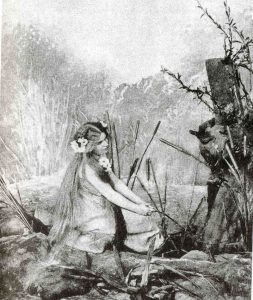I read a really great book recently. Like really, really, really great. It gave me the type of reading experience I didn’t even know I was craving. It was dark, and lush, and brooding, full of magical mayhem set against the oppressive, slate colored backdrop of the sea and its hidden horrors. Marketed as gothic fantasy, All the Murmuring Bones by A.G. Slatter certainly checked all the boxes of both categories, with a generous helping of folklore and a dash of abject horror.
The O’Malleys are a family that has always prospered and the reason why is their best kept secret. In exchange for safe passage for all of their merchant ships, they give one child of every generation to the Mer. For centuries this bargain is satisfied, but somewhere along the way the family ceases their offerings, and the bloodline is diluted until near extinction. Then their matriarch, and one of the last living “pure” O’Malleys, decides she will return them to their former glory, no matter the cost.
The protagonist, Miren, the last offshoot of the O’Malleys, is her grandmother’s price to pay. She is effectively sold to her own cousin, a man weak in the blood but strong in the pockets. With a crumbling estate and a name that is quickly fading into obscurity, Miren’s marriage to him is the family’s last hope for redemption. But Miren will not go quietly into this loveless union of convenience and instead embarks on an adventure to find her long lost and disgraced parents to start a new life out from under the shadow of the O’Malleys.
I made the rookie mistake of reading Goodreads reviews of this book shortly after I started it. Dear reader, NEVER do this. Why talk yourself out of an experience based on the whims and personal preferences of strangers? However, one rather scathing review actually hit the nail on the head when they said, “This book is trying to be too much.” I can totally see why they think that, but you know what, it worked for me. The plot whirlwinds around a mishmash of Norse, Slavic, Scottish, and Irish folklore, and we encounter all manner of magical, water bound creatures, including the Mer, rusalka, selkies, and kelpies. (Oh, my!) I was so entertained that I believe the differences between these beasts are now ingrained in my memory and I will no longer mix my mythicals, so to speak.
Rusalka - In Slavic folklore, the rusalka are malicious female entities bound to water. As with many other creatures of myth, scholars don't agree on the origins of the rusalka, but one theory is they stem from Slavic Paganism and were not originally perceived as dangerous. The concept resembles mermaids, with the key difference being rusalka are thought to be the embodied spirits of the dead, particularly women who died in or near a lake or river.
Rusalka is also the name of one of the most famous Czech operas, written by Antonín Dvořák and performed for the first time in Prague in 1901.
Selkie - In Celtic folklore, selkies are shapeshifters who change from seal to human by shedding their skin. Many of the folk tales of the selkie have been collected from the Northern Isles (Orkney and Shetland). The most popular variation of this myth involves a female selkie being tricked into marrying a human when he steals and hides her sealskin, binding her to her human form.
The origins are unclear, but here's my favorite theory of how a seal human hybrid ran away with imaginations: Some Scottish folklorists believe that Scottish settlers saw Inuits divesting themselves of their sealskin clothing or lying next to the skins on rocks, and this led to their belief in them changing from seal to man.
Kelpie - In Scottish folklore, the kelpie is a malevolent, shapeshifting spirit that most often takes the form of a horse. A common thread of the many variations of the kelpie myth is that their bridles are the source of their power, and if you manage to wrest it from their heads, they are at your command, or at least owe you a mighty favor, for which return of their bridle is the payment.
Very similar creatures exist in the lore of Germany, Scandinavia, Central America, and Australia. The most famous kelpie: The Loch Ness Monster.
If a little bit of mystery and creepiness at the water's edge suits your fancy for your Summer Reading, check out All the Murmuring Bones. It *is* a book that makes a lot of surprising stops in folklore but that's what makes it fun! Here's a list of other Tales of Mythical Tails for your Mer-ish reading needs:
-Leah Newton is a Readers' Services Assistant at Lawrence Public Library.




Add a comment to: Tales of Mythical Tails